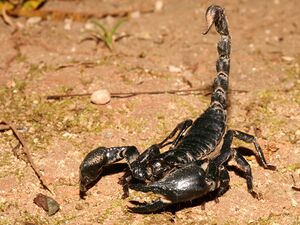Scorpions: Difference between revisions
No edit summary |
No edit summary |
||
| Line 1: | Line 1: | ||
[[File:Scorpion1.jpeg| | [[File:Scorpion1.jpeg|300px|thumb|left|Scorpion]] | ||
{| class="wikitable" style="text-align: center; width:80%;" | {| class="wikitable" style="text-align: center; width:80%;" | ||
Revision as of 12:32, 10 May 2023

| Kingdom | Phylum | Subphylum | Class | Order | |
|---|---|---|---|---|---|
| Classification | Animalia | Arthropoda | Chelicerata | Arachnida | Scorpiones |
Anatomy
Scorpions are invertebrates, which means that they do not have a backbone. All arthropods, including scorpions, spiders, insects, and crustaceans, are defined by their exoskeletons, jointed appendages, and segmented bodies. One of the most characteristic traits of scorpions are their long tails that curl over their backs and end with a venomous stinger. A scorpion's body is divided into two main parts which are the cephalothorax and the abdomen. The cephalothorax is located at the front of the body and are where a scorpion's four pairs of legs with setae are attached to the body. The cephalothorax includes their mouth parts and two large pincers known as pedipalps. Scorpions use their pinchers to help feel out their environment, defend themselves from predators, and to aid in trapping prey. Scorpions have two eyes on top of the cephalothorax but additionally have two to five pairs of eyes on the front corners and sides of their cephalothorax. Despite having multiple pairs of eyes, scorpions do not have good vision. However, their eyes are extremely light sensitive and allow them to see well in the dark or low lighting. The posterior portion of the body is the abdomen and includes the majority of their body length and their long tail, known as the metasoma. The metasoma has 5 segments and ends with the telson, which is the venom bulb. Inside of the telson are two venom glands that send the venom to the aculeus, commonly referred to as their stinger. Some scorpions have multiple toxins in their venom, with some species having over 40 toxins. Only around 30 species of scorpions have venom that is fatal to humans, but scorpion stings are known to cause pain, numbness, tingling, swelling, and warmth in the affected area.
Habitat and Range
1,500 scorpion species have been classified and it is likely that there are hundreds of species yet to be discovered. Of these 1,500 different species, around 40 species live in the United States. Scorpions can be found on every continent except for Antarctica and live in a variety of biomes including deserts, savannas, and rainforests. However, scorpions tend to prefer arid climates and deserts. Their range typically extends from Canada down to South America, and are found in central Europe, Africa, and Australia. They were accidentally spread to New Zealand and England by humans. Scorpions are solitary organisms and typically stay in the same territory for their entire lives. Scorpions live in small burrows underground that serve as protection from the weather and from predators. Because scorpions are nocturnal, they typically spend their days underground and emerge at night to hunt. Some scorpions climb trees or bury themselves under leaf litter and rocks instead of burrowing in the ground.
Diet and Behaviors
Scorpions mostly feed on insects, spiders, and small vertebrates like rodents and lizards. Although they prefer insects, they are opportunistic and will feed on a diversity of organisms when they required. Scorpions typically catch their prey by motionlessly waiting at the entrance to their underground burrows and striking with their stinger or grabbing with their pedipalps when prey wanders by. They use the hairs on their pedipalps to detect prey and can sense small ground vibrations to know when other organisms are around. Some scorpions prefer to seek out their prey or create pitfall traps in sand or soil that their prey fall into. They use their claws to snatch and crush smaller prey and use their stingers to take down larger or more difficult prey. Scorpions don't have a typical jaw and can only ingest liquid forms. They eat their prey by crushing it and covering it in digestive enzymes that dissolves the animal's organs. Once their meal has dissolved, which can take up to an hour, they suck up their liquid prey. Scorpions don't need to feed everyday and typically hunt for a meal once every two or three weeks. They can survive for long periods of time, even as long as 12 months, without food as long as they have water.
References
1. Kazilek. “Scorpion Anatomy.” Kazilek, 27 June 2016, https://askabiologist.asu.edu/scorpion-anatomy.
2. Orkin. “Scorpion Habitat - Where Do Scorpions Live?” Orkin, Orkin, 3 Aug. 2021, https://www.orkin.com/pests/stinging-pests/scorpions/scorpion-habitat.
3. “Scorpion Sting.” Mayo Clinic, Mayo Foundation for Medical Education and Research, 7 June 2022, https://www.mayoclinic.org/diseases-conditions/scorpion-stings/symptoms-causes/syc-20353859.
4. “Scorpion.” Encyclopædia Britannica, Encyclopædia Britannica, Inc., https://www.britannica.com/animal/scorpion.
5. “Scorpion.” San Diego Zoo Wildlife Alliance Animals and Plants, https://animals.sandiegozoo.org/animals/scorpion.
6. “Scorpion.” Wikipedia, Wikimedia Foundation, 19 Mar. 2023, https://en.wikipedia.org/wiki/Scorpion.
7. “Scorpions: National Geographic.” Animals, https://www.nationalgeographic.com/animals/invertebrates/facts/scorpions.